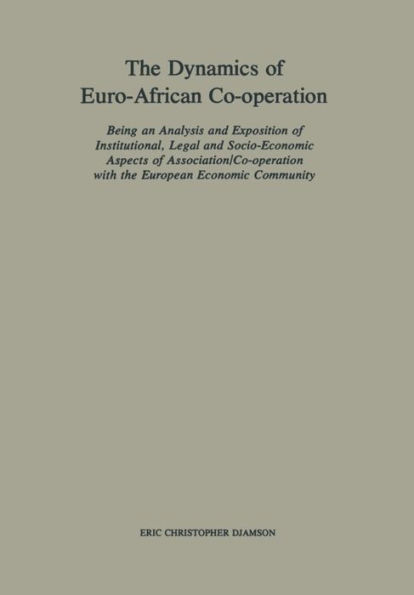The object of this study is to provide a guide to an understanding of the relationship between the European Economic Community and the Developing Countries. On 1 January, 19?3, the United Kingdom, Denmark and Ireland became Members of the European Economic Community, thus stepping up the number of Member States to nine. This enlargement of the Community opened a new phase of the relationship between the Community and the Developing Countries. In order to elaborate upon the evolution of this relationship, reliance must be placed on Part IV of the EEC Treaty, the provisions of the two Yaounde Conventions and the new ACP-EEC Convention of Lom~. The study is conceived of in six Chapters. The first Chapter deals with the background and early developments of the European Economic Community in relation to the concept of Association. The second considers a comparative analysis of the institutional provisions of the Yaounde Conventions. Chapter III is devoted to a historiaal study of certain provisions of Yaounde II Convention as a basis for the interpretation of the ACP-EEC Convention of LomA. The fourth Chapter deals with political and economic considerations - topics of considerable importance to the Contracting Parties, more particularly, the Developing Countries. A synoptic analysis of the ACP-EEC Convention of Lom6 is taken up in Chapter V, while Chapter VI sums up general conclusions based on Chapters I - V.
1112166136
The Dynamics of Euro-African Co-operation: Being an Analysis and Exposition of Institutional, Legal and Socio-Economic Aspects of Association/Co-operation with the European Economic Community
The object of this study is to provide a guide to an understanding of the relationship between the European Economic Community and the Developing Countries. On 1 January, 19?3, the United Kingdom, Denmark and Ireland became Members of the European Economic Community, thus stepping up the number of Member States to nine. This enlargement of the Community opened a new phase of the relationship between the Community and the Developing Countries. In order to elaborate upon the evolution of this relationship, reliance must be placed on Part IV of the EEC Treaty, the provisions of the two Yaounde Conventions and the new ACP-EEC Convention of Lom~. The study is conceived of in six Chapters. The first Chapter deals with the background and early developments of the European Economic Community in relation to the concept of Association. The second considers a comparative analysis of the institutional provisions of the Yaounde Conventions. Chapter III is devoted to a historiaal study of certain provisions of Yaounde II Convention as a basis for the interpretation of the ACP-EEC Convention of LomA. The fourth Chapter deals with political and economic considerations - topics of considerable importance to the Contracting Parties, more particularly, the Developing Countries. A synoptic analysis of the ACP-EEC Convention of Lom6 is taken up in Chapter V, while Chapter VI sums up general conclusions based on Chapters I - V.
54.99
In Stock
5
1

The Dynamics of Euro-African Co-operation: Being an Analysis and Exposition of Institutional, Legal and Socio-Economic Aspects of Association/Co-operation with the European Economic Community
527
The Dynamics of Euro-African Co-operation: Being an Analysis and Exposition of Institutional, Legal and Socio-Economic Aspects of Association/Co-operation with the European Economic Community
527
54.99
In Stock

Product Details
| ISBN-13: | 9789401503693 |
|---|---|
| Publisher: | Springer Netherlands |
| Publication date: | 01/01/1975 |
| Edition description: | 1975 |
| Pages: | 527 |
| Product dimensions: | 6.69(w) x 9.61(h) x 0.04(d) |
From the B&N Reads Blog
